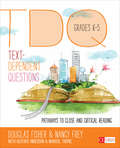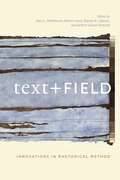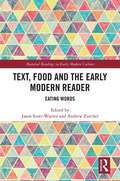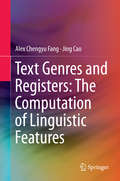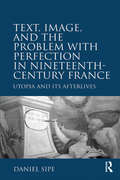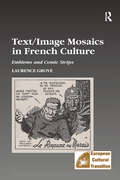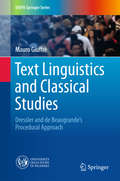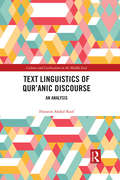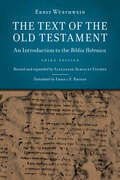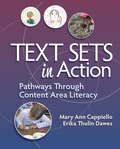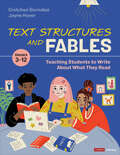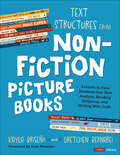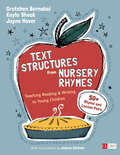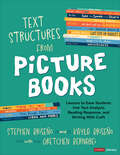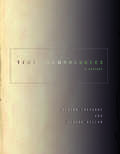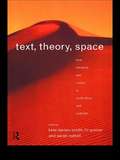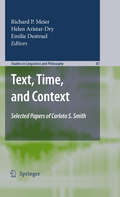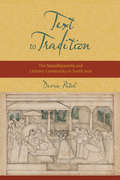- Table View
- List View
Text-Dependent Questions, Grades K-5: Pathways to Close and Critical Reading (Corwin Literacy)
by Douglas Fisher Dr Nancy Frey Heather L. Anderson Marisol ThayreFisher & Frey’s answer to close and critical reading Learn the best ways to use text-dependent questions as scaffolds during close reading and the big understandings they yield. But that’s just for starters. Fisher and Frey also include illustrative video, texts and questions, cross-curricular examples, and an online facilitator’s guide—making the two volumes of TDQ a potent professional development tool across all of K–12. The genius of TDQ is the way Fisher and Frey break down the process into four cognitive pathways: What does the text say? How does the text work? What does the text mean? What does the text inspire you to do?
Text-Dependent Questions, Grades K-5: Pathways to Close and Critical Reading (Corwin Literacy)
by Douglas Fisher Dr Nancy Frey Heather L. Anderson Marisol ThayreFisher & Frey’s answer to close and critical reading Learn the best ways to use text-dependent questions as scaffolds during close reading and the big understandings they yield. But that’s just for starters. Fisher and Frey also include illustrative video, texts and questions, cross-curricular examples, and an online facilitator’s guide—making the two volumes of TDQ a potent professional development tool across all of K–12. The genius of TDQ is the way Fisher and Frey break down the process into four cognitive pathways: What does the text say? How does the text work? What does the text mean? What does the text inspire you to do?
Text/Events in Early Modern England: Poetics of History
by Sandra LoganEngaging with a range of events-historical moments, theatrical performances, public presentations, and courtly intrigues - and the texts that record them, this book explores representational practice as a component of Elizabethan political culture. Considering the inscriptive production of mediated, indirect experience as an authorial challenge to the value of the immediate, direct experience of events, and conversely, recognizing the multi-valent impact of theatrical performance and performativity as a reinvigoration of the immediate, this study traces the emergence of 'realness' as a textual effect and a mode of political intervention. This interactive, refractive nexus of experience and inscription comprises what Sandra Logan calls the 'text/event'. The four primary foci of this investigation - the 1558 coronation entry; the 1575 entertainments at Kenilworth; the 1590s dramatizations of the reign of Richard II; and the Essex trial of 1601 - serve as exempla of four moments in the reign of Elizabeth I which suggest an increasingly complex interaction between events and texts developing in the last half of the sixteenth century. Logan argues that, in representing England's recent and distant past, a wide range of social subjects engaged in a struggle for intellectual credibility and social viability, and in the process generated a contingent public sphere within which history, framed as a coherent narrative shaped by causal relationships, was brought to bear on the concerns of the Elizabethan present and future. Assessing how these chronicles, short prose histories, and historical dramas each made use of the materials and techniques of the others, blurring the distinctions between historiography and poetry, as well as between past and present, Logan considers the conjunctions between the development of new genres and perceptions about inscription and experience, and changing socioeconomic institutions and practices.
Text + Field: Innovations in Rhetorical Method
by Robert Glenn Howard Robert Asen Sara L. McKinnon Karma R. ChávezRhetorical critics have long had a troubled relationship with method, viewing it as at times opening up provocative avenues of inquiry, and at other times as closing off paths toward meaningful engagement with texts. Text + Field shifts scholarly attention from this conflicted history, looking instead to the growing number of scholars who are supplementing text-based scholarship by venturing out into the field, where rhetoric is produced, enacted, and consumed. These field-based practices involve observation, ethnographic interviews, and performance. They are not intended to displace text-based approaches; rather, they expand the idea of method by helping rhetorical scholars arrive at new and complementary answers to long-standing disciplinary questions about text, context, audience, judgment, and ethics. The first volume in rhetoric and communication to directly address the relevance, processes, and implications of using field methods to augment traditional scholarship, Text + Field provides a framework for adapting these new tools to traditional rhetorical inquiry.Aside from the editors, the contributors are Roberta Chevrette, Kathleen M. de Onís, Danielle Endres, Joshua P. Ewalt, Alina Haliliuc, Aaron Hess, Jamie Landau, Michael Middleton, Tiara R. Na’puti, Jessy J. Ohl, Phaedra C. Pezzullo, Damien Smith Pfister, Samantha Senda-Cook, Lisa Silvestri, and Valerie Thatcher.
Text, Food and the Early Modern Reader: Eating Words (Material Readings in Early Modern Culture)
by Jason Scott-Warren Andrew Elder ZurcherIn early modern culture, eating and reading were entangled acts. Our dead metaphors (swallowed stories, overcooked narratives, digested information) are all that now remains of a rich interplay between text and food, in which every element of dining, from preparation to purgation, had its equivalent in the literary sphere. Following the advice of the poet George Herbert, this essay collection "looks to the mouth", unfolding the charged relationship between ingestion and expression in a wide variety of texts and contexts. With contributions from leading scholars in the field, Text, Food and the Early Modern Reader: Eating Words fills a significant gap in our understanding of early modern cultural history. Situated at the lively intersection between literary, historical and bibliographical studies, it opens new lines of dialogue between the study of material textuality and the history of the body.
Text Genres and Registers: The Computation of Linguistic Features
by Alex Chengyu Fang Jing CaoThis book is a description of some of the most recent advances in text classification as part of a concerted effort to achieve computer understanding of human language. In particular, it addresses state-of-the-art developments in the computation of higher-level linguistic features, ranging from etymology to grammar and syntax for the practical task of text classification according to genres, registers and subject domains. Serving as a bridge between computational methods and sophisticated linguistic analysis, this book will be of particular interest to academics and students of computational linguistics as well as professionals in natural language engineering.
Text, Image, and the Problem with Perfection in Nineteenth-Century France: Utopia and Its Afterlives
by Daniel SipeIn the decades after the French Revolution, philosophers, artists, and social scientists set out to chart and build a way to a new world and their speculative blueprints circulated like banknotes in a parallel economy of ideas. Examining representations of ideal societies in nineteenth-century French culture, Daniel Sipe argues that the dream-image of the literary or art-historical utopia does not disappear but rather is profoundly altered by its proximity to the social utopianism of the day. Sipe focuses on this persistent afterlife in utopias ranging from François-René de Chateaubriand’s Amerindian utopia in Atala (1801) to the utopian spoof of J.J. Grandville’s illustrated novel Un autre monde (1844). He proposes a new reading of Etienne Cabet’s seminal utopian novel, Voyage en Icarie (1840) and offers an original perspective on the gendered utopias of technological inspiration that authors such as Charles Barbara and Auguste Villiers de l’Isle-Adam penned in the second half of the century. In addition, Sipe considers utopias or important readings of the century’s rampant utopianism in, among others, Victor Hugo, Alfred de Vigny, Théophile Gautier, Charles Baudelaire, and Gustave Courbet. His book provides the historical context for comprehending the significance and implications of this enigmatic afterlife in nineteenth-century utopian art and literature.
Text/Image Mosaics in French Culture: Emblems and Comic Strips (Studies in European Cultural Transition)
by Laurance GroveThis study compares text/image interaction as manifested in emblem books (and related forms) and the modern bande dessinée, or French-language comic strip. It moves beyond the issue of defining the emblematic genre to examine the ways in which emblems - and their modern counterparts - interact with the surrounding culture, and what they disclose about that culture. Drawing largely on primary material from the Bibliothèque nationale de France and from Glasgow University Library's Stirling Maxwell Collection of emblem literature, Laurence Grove builds on the ideas of Marshall McLuhan, Elizabeth Eisenstein and, more recently, Neil Rhodes and Jonathan Sawday. Divided into four sections-Theoretics, Production, Thematics and Reception-Text/Image Mosaics in French Culture broaches topics such as theoretical approaches (past and present) to text/image forms, the question of narrative within the scope of text/image creations, and the reuse of visual iconography for diametrically opposed political or religious purposes. The author argues that, despite the gap in time between the advent of emblems and that of comic strips, the two forms are analogous, in that both are the products of a 'parallel mentality'. The mindsets of the periods that popularised these forms have certain common features related to repeated social conditions rather than to the pure evolution over time. Grove's analysis and historical contextualisation of that mentality provide insight into our own popular culture forms, not only the comic strip but also other hybrid media such as advertising and the Internet. His juxtaposition of emblems and the bande dessinée increases our understanding of all such combinations of picture and text.
Text Linguistics and Classical Studies
by Mauro GiuffrèThe work represents a significant scientific advancement on text linguistics from three different viewpoints. The first chapter provides an overview of the history of text linguistics from a broader perspective than usual, offering a complete reference framework. The second chapter presents the procedural approach to the study of text linguistics in a concise way, including a critical comparison with other perspectives. The third chapter constructs a very unusual bridge between theoretical linguistics and classical studies in that it takes a literary text in Latin from the early imperial period as its case study. This combination is rare, as theoretical linguists are usually oriented to modern languages and classicists are not generally inclined to the study of formal linguistics. It also offers an interesting perspective that intersects the studies of general linguistics and glottology, which makes this volume of interest to general linguists, classicists, philologists and literary critics alike.
Text Linguistics of Qur'anic Discourse: An Analysis (Culture and Civilization in the Middle East)
by Hussein Abdul-RaofText Linguistics of Qur'anic Discourse is an in-depth investigation of the fabric of Qur'anic Discourse. It unravels the texture of the macro Qur'anic text; its cohesion and coherence systems; the notions of intertextuality, semantic relatedness, and thematic sequentiality; the macro textual features of ellipsis, repetition, and argumentation structure; and the contextual, co-textual, grammatical, and semantic factors involved in the macro Qur'anic text. This book is a valuable and methodologically consistent learning and teaching academic resource for universities worldwide in this intriguing new discipline. Through its methodologically coherent discussion and in-depth analysis that is hinged upon modern European text linguistics, Text Linguistics of Qur'anic Discourse provides an insight into the newly established discipline of text linguistics, and explores the different layers of the macro Qur'anic text as an academic requirement.
The Text of the Old Testament: An Introduction to the Biblia Hebraica
by Ernst Wurthwein Alexander Achilles FischerKristin De Troyer — University of St. Andrews &“This finely revised and nicely updated version of one of the classics in our field can truly be called a grand introduction to the history of the biblical text.&”Leonard Greenspoon — Creighton University &“Readers familiar with Würthwein&’s earlier work will discover all of the strengths of his approach to Biblical Hebrew. Old and new readers will enjoy the thoroughly up-to-date discussion of the aims and methods of textual criticism as well as the unbiased analysis of ancient versions and their modern scholarly editions. Beautifully reproduced plates are easy to read, and the updated bibliography is satisfyingly full. . . . This successful project can be easily digested by newcomers and savored by specialists.&”Robert L. Hubbard — North Park Theological Seminary &“A very welcome, thorough revision of the long-honored standard introduction to the Masoretic text. Its integration of recent scholarship is first-rate, and the rewritten text retains the clear, accessible style that won its predecessors decades of popularity as a textbook. Yet another generation of students will find in this book a friendly, reliable guide through the complex terrain of ancient Hebrew texts and their relationships. Highly commended.&”The Bible Today &“Every scholar and serious Bible student should have a passing knowledge of the work of the text critic. This book will provide such knowledge.&”Books at a Glance "An important, up-to-date resource that will benefit everyone interested in Old Testament Textual criticism. The excellent bibliography, diagrams, and plates are unique contributions among introductory works in the field. Highly recommended."
Text Sets in Action: Pathways Through Content Area Literacy
by Mary Ann Cappiello Erika Thulin DawesFinding ways to organize your classroom instruction for knowledge building and literacy learning can be challenging. How can you incorporate more nonfiction and informational text in your content area curriculum while expanding and deepening representation with diverse texts? What can motivate student learning while providing equity and access for different learning styles and needs? Text sets are the answer!In Text Sets in Action: Pathways Through Content Area Literacy, authors Erika Thulin Dawes and Mary Ann Cappiello demonstrate how text sets offer students the opportunity to build critical thinking skills and informational literacy while generating interest and engagement across the content areas. Put your students in the center of the meaning-making in your classroom with multimodal multi-genre text sets in action. In Text Sets in Action, the authors: Model how text sets build foundational skills and metacognitive strategies as students experience a carefully scaffolded and sequenced exploration of ideas, academic, and content vocabularyExplain how text sets encourage classroom discussion by having students ask questions about what they read, debate different perspectives, and relate the texts to their own personal experiences and the changes they would like to see in the worldShow how children's literature and multimodal, multi-genre texts can serve as mentor texts for student writing and inspire creativity and advocacyDemonstrate how to curate text sets that can introduce diverse and underrepresented voices into the classroom, fostering appreciation for different points of view and generate deeper critical thinkingProvide resources and suggestions for designing text sets a multimodal, multi-genre text set can include children's literature of all genres, as well as digital texts, YouTube videos, news articles, podcasts, and more Text Sets in Action will help you create a collection of text sets that can be added to or edited over the years to align with your lesson plan goals. Teachers who have adopted this approach saw greater student reading comprehension and critical thinking skills. By introducing a multitude of text, teachers will ignite a spirit of inquiry and engagement for lifelong learning.
Text Structure Reading Comprehension Book Reading Level 3.5 - 5.0
by EdupressWelcome to the Edupress Text Structure Reading Comprehension Book. This resource is an effective tool for instruction, practice, and evaluation of student understanding. It includes ideas on how to introduce different text structures to students, as well as activities to help teach and practice the concepts.
Text Structures and Fables: Teaching Students to Write About What They Read, Grades 3-12 (Corwin Literacy)
by Gretchen S. Bernabei Jayne HoverState tests are assessing reading and writing together—Are you ready? I wish students would interact with a text on their own…I wish it wasn’t like pulling teeth to get them to elaborate their thinking. Wish no more, because bestselling author Gretchen Bernabei shows you how to guide students to be nimble at both short answer and extended responses. Her secret? "Teach students text structures, and they can pour their swirling ideas about the text into cogent writing." Using the accessible format of fables, Bernabei and Hover share lessons and an appendix full of fables so you can teach students five concrete ways to respond to text in any genre: Generate basic responses, using structures that support clarity Craft fiction inspired by the text to unveil literary knowledge and imaginative response Write essays about a theme or moral that display empathic and evidence-based interpretation Answer open-ended questions by selecting a technique that reflects the text and their engagement Use non-traditional formats like graphics and spoken dialogue to showcase their learning The heat is on—beginning in third grade, state tests are now assessing reading and writing together. And that’s a good thing, but we’ve got some catching up to do. With Text Structures and Fables in hand, your students will swiftly and surely become text-savvy readers and writers.
Text Structures and Fables: Teaching Students to Write About What They Read, Grades 3-12 (Corwin Literacy)
by Gretchen S. Bernabei Jayne HoverState tests are assessing reading and writing together—Are you ready? I wish students would interact with a text on their own…I wish it wasn’t like pulling teeth to get them to elaborate their thinking. Wish no more, because bestselling author Gretchen Bernabei shows you how to guide students to be nimble at both short answer and extended responses. Her secret? "Teach students text structures, and they can pour their swirling ideas about the text into cogent writing." Using the accessible format of fables, Bernabei and Hover share lessons and an appendix full of fables so you can teach students five concrete ways to respond to text in any genre: Generate basic responses, using structures that support clarity Craft fiction inspired by the text to unveil literary knowledge and imaginative response Write essays about a theme or moral that display empathic and evidence-based interpretation Answer open-ended questions by selecting a technique that reflects the text and their engagement Use non-traditional formats like graphics and spoken dialogue to showcase their learning The heat is on—beginning in third grade, state tests are now assessing reading and writing together. And that’s a good thing, but we’ve got some catching up to do. With Text Structures and Fables in hand, your students will swiftly and surely become text-savvy readers and writers.
Text Structures From Nonfiction Picture Books: Lessons to Ease Students Into Text Analysis, Reading Response, and Writing With Craft (Corwin Literacy)
by Kayla Briseño Gretchen BernabeiUse Nonfiction Picture Books for Lively, High-Impact Lessons That Inspire Student Reading, Writing, and Response Want to make an unbelievable story utterly irresistible to young readers? Make sure the story’s true. Nonfiction, like poetry, can have a bad reputation for being boring, but in the hands of able picture book authors, it’s anything but. In Text Structures From Nonfiction Picture Books, elementary and middle grade teachers can channel the curiosity piqued from amazing true tales to help students further their reading comprehension and writing skills. With the bite-sized format of nonfiction picture books as a starting point, this practical book shares over 40 low-prep, quick-access lessons to get students reading, writing, and responding to nonfiction texts with ease. The book provides a wealth of instruction, including: Step-by-step lessons with multiple ways to use each picture book to prompt students’ writing and analysis of the text An extensive list of nonfiction picture book titles organized by "books about people," "books about places," "books about things," and "books about animals" Topics, text structures, and writer’s craft moves provided for each book Lessons that introduce kernel essays, truisms, and reading response Embedded terms, examples, and assignments to teach the vocabulary of writer’s craft including refrain, polysyndeton, antithesis, and more! Based on master writing teacher Gretchen Bernabei’s instructional model, the lessons offer a lively, high-impact mix of reading aloud, discussion, modeling, student writing, and peer share. Plus, readers have access to a complete companion website full of text structure reproducibles, reading response prompts, additional lessons and extensions, student samples, and links to demo videos.
Text Structures From Nonfiction Picture Books: Lessons to Ease Students Into Text Analysis, Reading Response, and Writing With Craft (Corwin Literacy)
by Kayla Briseño Gretchen BernabeiUse Nonfiction Picture Books for Lively, High-Impact Lessons That Inspire Student Reading, Writing, and Response Want to make an unbelievable story utterly irresistible to young readers? Make sure the story’s true. Nonfiction, like poetry, can have a bad reputation for being boring, but in the hands of able picture book authors, it’s anything but. In Text Structures From Nonfiction Picture Books, elementary and middle grade teachers can channel the curiosity piqued from amazing true tales to help students further their reading comprehension and writing skills. With the bite-sized format of nonfiction picture books as a starting point, this practical book shares over 40 low-prep, quick-access lessons to get students reading, writing, and responding to nonfiction texts with ease. The book provides a wealth of instruction, including: Step-by-step lessons with multiple ways to use each picture book to prompt students’ writing and analysis of the text An extensive list of nonfiction picture book titles organized by "books about people," "books about places," "books about things," and "books about animals" Topics, text structures, and writer’s craft moves provided for each book Lessons that introduce kernel essays, truisms, and reading response Embedded terms, examples, and assignments to teach the vocabulary of writer’s craft including refrain, polysyndeton, antithesis, and more! Based on master writing teacher Gretchen Bernabei’s instructional model, the lessons offer a lively, high-impact mix of reading aloud, discussion, modeling, student writing, and peer share. Plus, readers have access to a complete companion website full of text structure reproducibles, reading response prompts, additional lessons and extensions, student samples, and links to demo videos.
Text Structures From Nursery Rhymes: Teaching Reading and Writing to Young Children (Corwin Literacy)
by Gretchen S. Bernabei Kayla Shook Jayne HoverA Revolutionary Strategy for Teaching Writing to Children How can we shape young students, often just learning how to hold a pencil, into capable writers? This groundbreaking book offers the solution: a clear framework for guiding children to write in any style, from narrative to persuasive. The key lies in using familiar text structures to break down a story into its main components, immediately thrusting students into the role of the writer. Included are 53 lessons, each centered around a classic nursery rhyme, and all the tools you’ll need to lead your students in crafting their own story — in words, pictures, or both. Discover how text structures, already a success in later grades, can also have a profound impact on younger students’ progress.
Text Structures From Nursery Rhymes: Teaching Reading and Writing to Young Children (Corwin Literacy)
by Gretchen S. Bernabei Kayla Shook Jayne HoverA Revolutionary Strategy for Teaching Writing to Children How can we shape young students, often just learning how to hold a pencil, into capable writers? This groundbreaking book offers the solution: a clear framework for guiding children to write in any style, from narrative to persuasive. The key lies in using familiar text structures to break down a story into its main components, immediately thrusting students into the role of the writer. Included are 53 lessons, each centered around a classic nursery rhyme, and all the tools you’ll need to lead your students in crafting their own story — in words, pictures, or both. Discover how text structures, already a success in later grades, can also have a profound impact on younger students’ progress.
Text Structures From Picture Books [Grades 2-8]: Lessons to Ease Students Into Text Analysis, Reading Response, and Writing With Craft (Corwin Literacy)
by Stephen Briseño Kayla Briseño Gretchen BernabeiTeach students the architecture beneath a successful story—and boost their reading comprehension and writing skills for a lifetime Writing instruction can sometimes seem scattershot, as teachers try to cover a galaxy of craft techniques, ideas, intentions, and genres. The possibilities are endless—and that’s the problem. In Text Structures from Picture Books, elementary and middle grade teachers tap into a well-ordered universe of inspiring and illustrative stories to help students frame their thinking and focus choices. Using the bite-size format of picture books as a starting point, the authors share 50 low-prep, quick-access lessons to help you teach students seven concrete ways to respond to text in any genre. Through these lessons, students will be able to: Generate their own writing, using a text structure harvested from the work of professional authors Retell a story, using the text structure from the story Generate reading responses, using structures that support clarity Analyze a story to construct thematic statements, capturing the author’s message and bigger themes Write about a theme or big idea demonstrating empathic and evidence-based interpretation Answer open-ended questions by selecting a technique that reflects the text and their engagement Experiment with author’s craft in their own writing Based on master writing teacher Gretchen Bernabei’s instructional model, the lessons offer a lively, high-impact mix of reading aloud, discussion, modeling, student writing, and peer share. Plus, readers have access to a complete companion website full of text structure reproducibles, reading response prompts, additional lessons and extensions, students samples, and links to demo videos. State tests are now assessing reading and writing together. And that’s a good thing—but we’ve got some catching up to do. Written for students beginning in second grade, Text Structures from Picture Books will help your students swiftly and surely become text-savvy readers and writers.
Text Structures From Picture Books [Grades 2-8]: Lessons to Ease Students Into Text Analysis, Reading Response, and Writing With Craft (Corwin Literacy)
by Stephen Briseño Kayla Briseño Gretchen BernabeiTeach students the architecture beneath a successful story—and boost their reading comprehension and writing skills for a lifetime Writing instruction can sometimes seem scattershot, as teachers try to cover a galaxy of craft techniques, ideas, intentions, and genres. The possibilities are endless—and that’s the problem. In Text Structures from Picture Books, elementary and middle grade teachers tap into a well-ordered universe of inspiring and illustrative stories to help students frame their thinking and focus choices. Using the bite-size format of picture books as a starting point, the authors share 50 low-prep, quick-access lessons to help you teach students seven concrete ways to respond to text in any genre. Through these lessons, students will be able to: Generate their own writing, using a text structure harvested from the work of professional authors Retell a story, using the text structure from the story Generate reading responses, using structures that support clarity Analyze a story to construct thematic statements, capturing the author’s message and bigger themes Write about a theme or big idea demonstrating empathic and evidence-based interpretation Answer open-ended questions by selecting a technique that reflects the text and their engagement Experiment with author’s craft in their own writing Based on master writing teacher Gretchen Bernabei’s instructional model, the lessons offer a lively, high-impact mix of reading aloud, discussion, modeling, student writing, and peer share. Plus, readers have access to a complete companion website full of text structure reproducibles, reading response prompts, additional lessons and extensions, students samples, and links to demo videos. State tests are now assessing reading and writing together. And that’s a good thing—but we’ve got some catching up to do. Written for students beginning in second grade, Text Structures from Picture Books will help your students swiftly and surely become text-savvy readers and writers.
Text Technologies: A History (Stanford Text Technologies)
by Elaine Treharne Claude WillanThe field of text technologies is a capacious analytical framework that focuses on all textual records throughout human history, from the earliest periods of traceable communication—perhaps as early as 60,000 BCE—to the present day. At its core, it examines the material history of communication: what constitutes a text, the purposes for which it is intended, how it functions, and the social ends that it serves. This coursebook can be used to support any pedagogical or research activities in text technologies, the history of the book, the history of information, and textually-based work in the digital humanities. Through careful explanations of the field, examinations of terminology and themes, and illustrated case studies of diverse texts—from the Cyrus cylinder to the Eagles' "Hotel California"—Elaine Treharne and Claude Willan offer a clear yet nuanced overview of how humans convey meaning. Text Technologies will enable students and teachers to generate multiple lines of inquiry into how communication—its production, form and materiality, and reception—is crucial to any interpretation of culture, history, and society.
Text, Theory, Space: Land, Literature and History in South Africa and Australia
by Kate Darian-Smith Liz Gunner Sarah NuttallText, Theory, Space is a landmark in post-colonial criticism and theory. Focusing on two white settler societies, South Africa and Australia, the contributors investigate the meaning of 'the South' as an aesthetic, political, geographical and cultural space. Drawing upon a wide range of disciplines which include literature, history, urban and cultural geography, politics and anthropology, the contributors examine crucial issues including: * defining what 'the South' encompasses * investigating ideas of space, history, land and landscape * claiming, naming and possessing land * national and personal boundaries * questions of race, gender and nationalism
Text, Time, and Context
by Emilie Destruel Richard P. Meier Helen Aristar-DryCarlota S. Smith was a key figure in linguistic research and a pioneering woman in generative linguistics. This selection of papers focuses on the research into tense, aspect, and discourse that Smith completed while Professor of Linguistics at the University of Texas at Austin. Smith's early work in English syntax is still cited today, and her early career also yielded key research on language acquisition by young children. Starting in the mid-1970s, after her move to UT, she embarked on her most important line of research. In numerous papers - the first of which was published in 1975 - and in a very important 1991 book (The Parameter of Aspect), Smith analyzed how languages encode time and how they encode the ways events and situations occur over time. Smith's work on the expression of time in language is notable because of its careful analyses of a number of quite different languages, including not only English and French, but also Russian, Mandarin, and Navajo. Inspired by a year in France in the early 1970s, Smith began to analyze the differing ways in which languages encode time and how they encode the ways events and situations occur over time. In doing so, she developed her signature 'two-component' theory of aspect. This model of temporal aspect provided an excellent framework for graduate students seeking to analyze the temporal systems of an array of languages, including under-described languages that are so much the focus of research in UT's Linguistics Department. Selected by Carlota Smith herself and by her longtime friends and colleagues, this book contains her 1980 piece on temporal structures in discourse, her 1986 comparison of the English and French aspectual systems, a 1996 paper on the aspect system in Navajo (an increasingly-endangered language which Smith worked to preserve), and her 1980 and 1993 papers on the child's acquisition of tense and aspect. Smith, who died in 2007, was a trailblazer in her field whose broad interests fed into her scholarly research. She was an avid reader who sought to bring the analytic tools of linguistics to the humanistic study of literature, by examining the syntactic and pragmatic principles which underlie literary effects. Her research on rhetorical and temporal effects in context was integrated into her last book, Modes of Discourse (2003). The current volume of articles covers much of her most fruitful work on the way in which language is used to express time, and will be essential reading for many working and studying in linguistics generally and in semantics particularly.
Text to Tradition: The Naisadhiyacarita and Literary Community in South Asia (South Asia Across the Disciplines)
by Deven M. PatelWritten in the twelfth century, the Naisadhiyacarita (The Adventures of Nala, King of Nisadha) is a seminal Sanskrit poem beloved by South Asian literary communities for nearly a millennium. This volume introduces readers to the poem's author, his reading communities, the modes through which the poem has been read and used, the contexts through which it became canonical, its literary offspring, and the emotional power it still holds for the culture that values it.Text to Tradition privileges the intellectual, affective, and social forms of cultural practice that inform a region's people and institutions. It also proposes a new way to conduct literary historiography, understanding literary texts as "traditions" in their own right and emphasizing the various players and critical genres involved in their reception. The book underscores the importance of the close study of individual works to building a history of literary cultures. In addition, it creates a groundbreaking model for approaching the study of other venerated South Asian texts.
